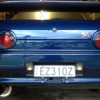Rb26 Raised Compression
Announcements
-
Similar Content
-
Latest Posts
-
I personally would go with cutting out the rubber. Then deal with getting sleeve off separately. Rubber can be painful to cut, it loves to jam up cutting tools. I normally have success with drill bits, deburr bits, angle grinders, jigsaw, reciprocating saw, and never forget... fire. Obviously different tools won't work in all locations you're trying to work with, and you need to be comfortable with each. You personally may be happy slowly slicing it out with a razor blade, if you are, go for it with one too! Feel free to wait for others to weigh in also on their thoughts.
-
By DatsunBanana · Posted
So ... I got everything disconnected and started dropping the frame. Three of the four mounts started to come down but the fourth one (the one with the nut that gave me all the trouble) won't budge. The inner metal sleeve stays up tight against the chassis rail although the outer part of the mount drops a bit (and can be levered quite a lot more) but it's just stretching the rubber bushing. So I reckon there's some serious corrosion inside the inner sleeve and holding it tight to the lug at the top of the bolt. Tried everything I can think of so far: penetrating oil, whacking the top of the sleeve to vibrate it and wedge a screwdriver blade in there. I also tried to turn the inner sleeve a bit by hitting it with a chisel at the bottom. It's stuck solid. What do you think about cutting the rubber with a blade so I can drop the subframe around it anyway. Then worry about getting the inner sleeve off after? Will that work? Is it gonna give me even more problems? -
Steam valve seals are usually responsible for cold start smoke, it goes away once engine warmed up. Disconnect it let engine breathers and let it breath freely, see if problem goes away after a short drive. Also check to make sure engine oil drain pipe is not blocked or kinked.
-
By TurboTapin · Posted
Haha thanks! Yea I'm moving over from 2x 1000cc jets pre throttle over to 6x 190cc direct port jets and 1x 500cc pre throttle jet. Direct port comes with all the advantages you would expect, except that pre throttle does cool down IAT'S more. That's why my direct port nozzle placement is closest to the plenum as possible in the runners to allow the air more time to cool before being sucked in. I'm also putting that one 500cc pre throttle jet to help with more cooling. It's a hybrid system. There's a lot more advantages to moving over to a PWM solenoid with a constant pressure system vs my old PWM pump setup, but I'll get more into that once I'm done converting everything over. The ricer in me is excited to see SS tubing all over my manifold though! -
By Dose Pipe Sutututu · Posted
Very cool, see what I did there? 🥲 Wild WMI setup, first I've seen where it's on each cylinder runner, usually I see a single jet pre throttle.
-










Recommended Posts
Create an account or sign in to comment
You need to be a member in order to leave a comment
Create an account
Sign up for a new account in our community. It's easy!
Register a new accountSign in
Already have an account? Sign in here.
Sign In Now